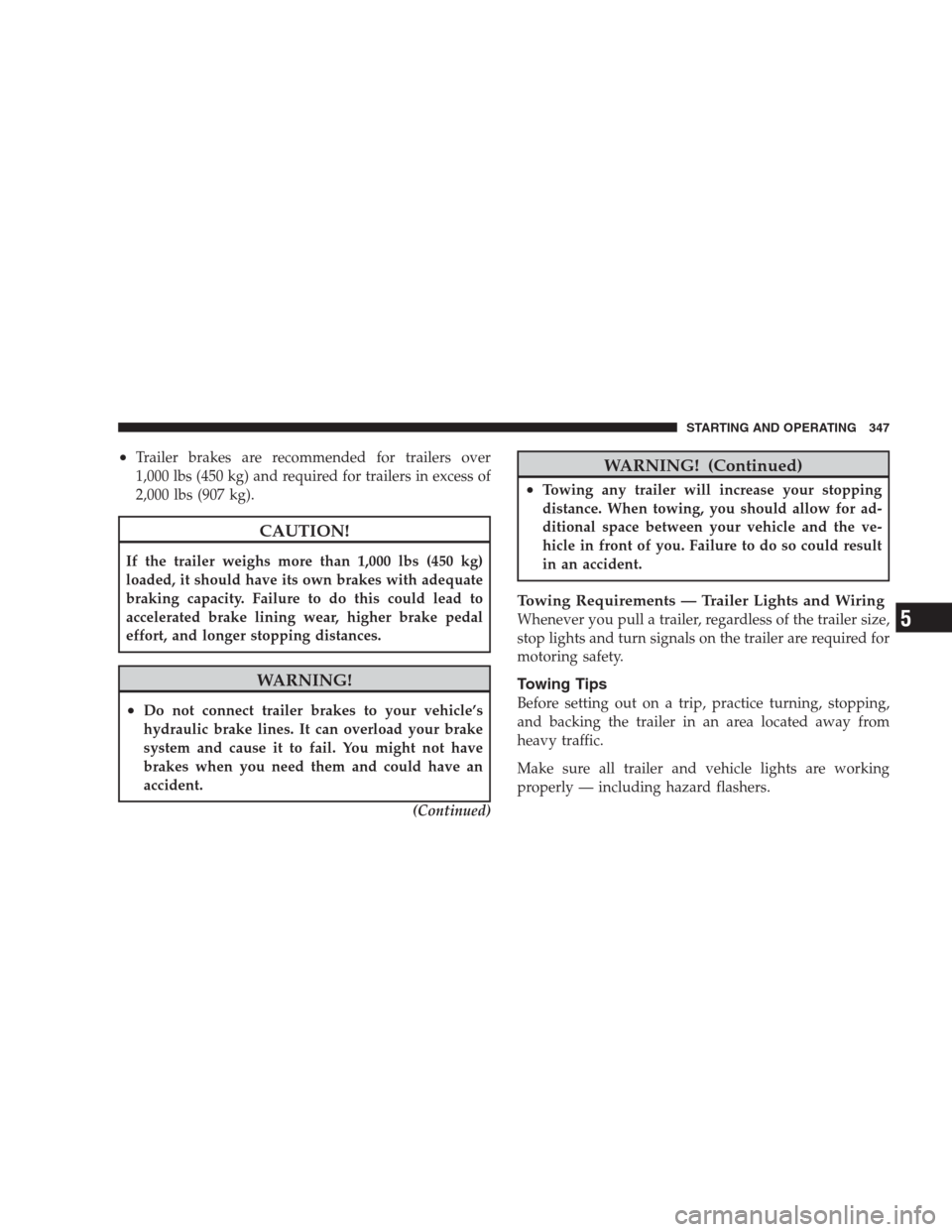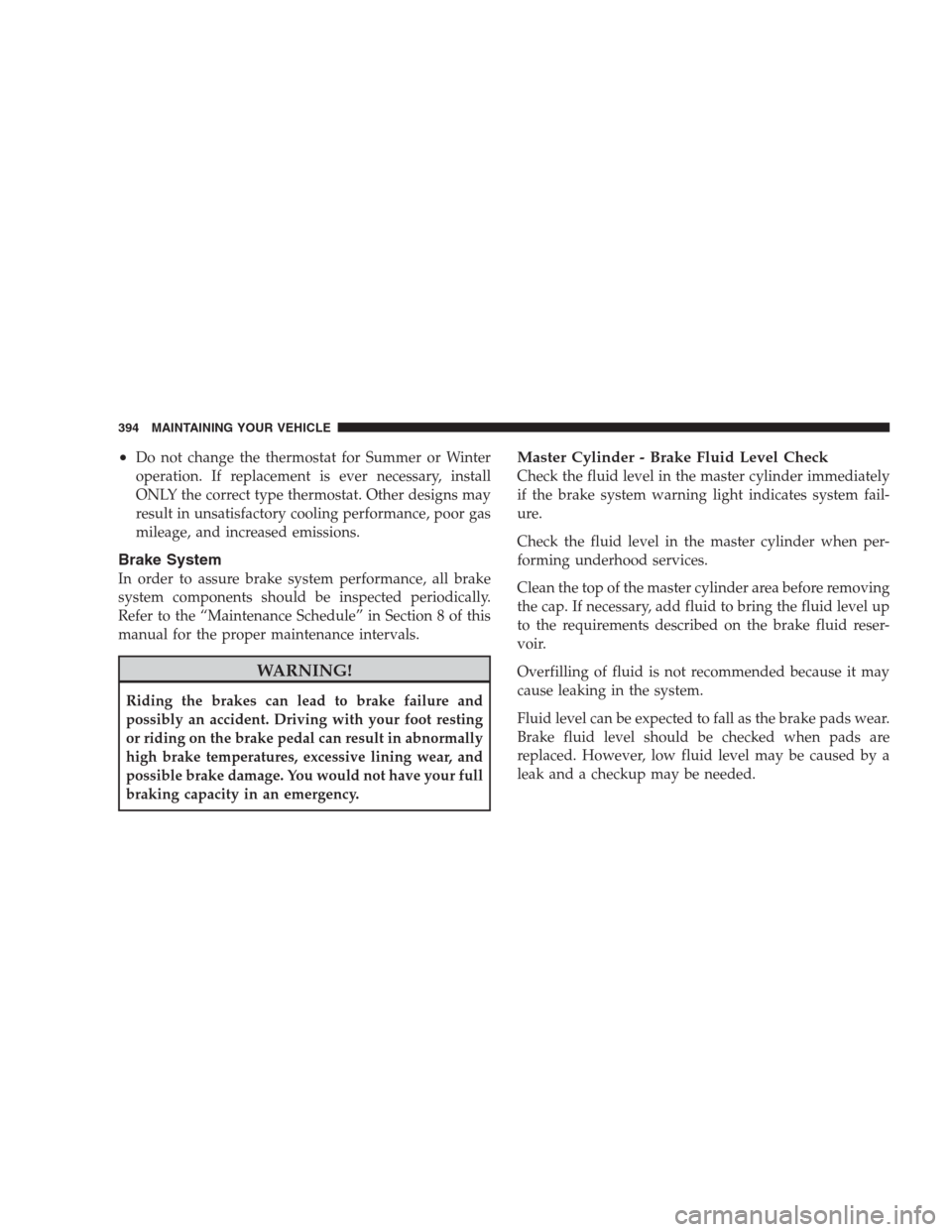Page 296 of 475

Electronic Stability Program (ESP)
This system enhances directional control and stability of
the vehicle under various driving conditions. ESP cor-
rects for over/under steering of the vehicle by applying
the brake of the appropriate wheel to assist in counter-
acting the over/under steer condition. Engine power
may also be reduced to help the vehicle maintain the
desired path. ESP uses sensors in the vehicle to determine
the vehicle path intended by the driver and compares it
to the actual path of the vehicle. When the actual path
does not match the intended path, ESP applies the brake
of the appropriate wheel to assist in counteracting the
oversteer or understeer condition
•Oversteer - when the vehicle is turning more than
appropriate for the steering wheel position.
•Understeer - when the vehicle is turning less than
appropriate for the steering wheel position.
ESP/TCS Indicator Light
The “ESP/TCS Indicator Light, located in the instrument
cluster, starts to flash as soon as the tires lose traction and
the ESP system becomes active. The ESP/TCS Indicator
Light also flashes when TCS is active. If the ESP/TCS
Indicator Light begins to flash during acceleration, ease
up on the accelerator and apply as little throttle as
possible. Be sure to adapt your speed and driving to the
prevailing road conditions.
WARNING!
•Electronic Stability Program (ESP) cannot prevent
the natural laws of physics from acting on the
vehicle, nor can it increase the traction afforded by
prevailing road conditions.
(Continued)
294 STARTING AND OPERATING
Page 349 of 475

•Trailer brakes are recommended for trailers over
1,000 lbs (450 kg) and required for trailers in excess of
2,000 lbs (907 kg).
CAUTION!
If the trailer weighs more than 1,000 lbs (450 kg)
loaded, it should have its own brakes with adequate
braking capacity. Failure to do this could lead to
accelerated brake lining wear, higher brake pedal
effort, and longer stopping distances.
WARNING!
•Do not connect trailer brakes to your vehicle’s
hydraulic brake lines. It can overload your brake
system and cause it to fail. You might not have
brakes when you need them and could have an
accident.
(Continued)
WARNING! (Continued)
•Towing any trailer will increase your stopping
distance. When towing, you should allow for ad-
ditional space between your vehicle and the ve-
hicle in front of you. Failure to do so could result
in an accident.
Towing Requirements — Trailer Lights and Wiring
Whenever you pull a trailer, regardless of the trailer size,
stop lights and turn signals on the trailer are required for
motoring safety.
Towing Tips
Before setting out on a trip, practice turning, stopping,
and backing the trailer in an area located away from
heavy traffic.
Make sure all trailer and vehicle lights are working
properly — including hazard flashers.
STARTING AND OPERATING 347
5
Page 370 of 475

▫Windshield Washers.................. 385
▫Exhaust System..................... 386
▫Cooling System..................... 388
▫Brake System....................... 394
▫Automatic Transaxle.................. 395
▫Appearance Care And Protection From
Corrosion.......................... 398
▫Cleaning Center Console Cupholders...... 403
▫Convertible Top Care................. 403
▫Weather Strip Care — Soft & Hard Top..... 405
�Fuses.............................. 405
▫Totally Integrated Power Module (TIPM) . . . 405
�Vehicle Storage....................... 411�Replacement Bulbs.................... 411
�Bulb Replacement..................... 412
▫Headlight.......................... 412
▫Front Turn Signal/Parking Light......... 414
▫Front Fog Light..................... 414
▫Tail/Stop, Rear Turn Signal And Backup
Lights............................ 416
▫License Plate Light................... 418
▫Center High-Mounted Stop Light (CHMSL) . . 419
�Fluids And Capacities.................. 420
�Fluids, Lubricants, And Genuine Parts....... 421
▫Engine............................ 421
368 MAINTAINING YOUR VEHICLE
Page 396 of 475

•Do not change the thermostat for Summer or Winter
operation. If replacement is ever necessary, install
ONLY the correct type thermostat. Other designs may
result in unsatisfactory cooling performance, poor gas
mileage, and increased emissions.
Brake System
In order to assure brake system performance, all brake
system components should be inspected periodically.
Refer to the “Maintenance Schedule” in Section 8 of this
manual for the proper maintenance intervals.
WARNING!
Riding the brakes can lead to brake failure and
possibly an accident. Driving with your foot resting
or riding on the brake pedal can result in abnormally
high brake temperatures, excessive lining wear, and
possible brake damage. You would not have your full
braking capacity in an emergency.
Master Cylinder - Brake Fluid Level Check
Check the fluid level in the master cylinder immediately
if the brake system warning light indicates system fail-
ure.
Check the fluid level in the master cylinder when per-
forming underhood services.
Clean the top of the master cylinder area before removing
the cap. If necessary, add fluid to bring the fluid level up
to the requirements described on the brake fluid reser-
voir.
Overfilling of fluid is not recommended because it may
cause leaking in the system.
Fluid level can be expected to fall as the brake pads wear.
Brake fluid level should be checked when pads are
replaced. However, low fluid level may be caused by a
leak and a checkup may be needed.
394 MAINTAINING YOUR VEHICLE
Page 402 of 475

Wheel and Wheel Trim Care
All wheels and wheel trim, especially aluminum and
chrome plated wheels, should be cleaned regularly with
a mild soap and water to prevent corrosion. To remove
heavy soil and/or excessive brake dust, use MOPAR�
Wheel Cleaner or equivalent or select a nonabrasive,
non-acidic cleaner. Do not use scouring pads, steel wool,
a bristle brush, or metal polishes. Only MOPAR�or
equivalent is recommended. Do not use oven cleaner.
Avoid automatic car washes that use acidic solutions or
harsh brushes that may damage the wheels’ protective
finish.
Cleaning Headlights
Your vehicle has plastic headlights that are lighter and
less susceptible to stone breakage than glass headlights.
Plastic is not as scratch resistant as glass and therefore
different lens cleaning procedures must be followed.To minimize the possibility of scratching the lenses and
reducing light output, avoid wiping with a dry cloth. To
remove road dirt, wash with a mild soap solution fol-
lowed by rinsing.
Do not use abrasive cleaning components, solvents, steel
wool or other aggressive material to clean the lenses.
Interior Care
Instrument Panel Cover
The instrument panel cover has a low glare surface,
which minimizes reflections in the windshield. Do not
use protectants or other products, which may cause
undesirable reflections. Use soap and warm water to
restore the low glare surface.
Cleaning Interior Trim
Interior Trim should be cleaned starting with a damp
cloth, a damp cloth with MOPAR�Total Clean, then
400 MAINTAINING YOUR VEHICLE
Page 408 of 475
CavityCartridge
FuseMini
FuseDescription
140 Amp
Green—Power Top Mod-
ule (If Equipped)
2—20 Amp
YellowAWD Module
CavityCartridge
FuseMini
FuseDescription
3—10 Amp
RedBattery Feed —
Center High
Mounted Stop
Light (CHMSL)/
Brake Switch
4—10 Amp
RedBattery Feed —
Ignition Switch
5—20 Amp
YellowTrailer Tow — If
Equipped
6—10 Amp
RedIgnition Off
Draw (IOD) —
Power Mirror
Switch/Climate
Controls
7—30 Amp
GreenIgnition Off
Draw (IOD)
Sense 1
Totally Integrated Power Module (TIPM)
406 MAINTAINING YOUR VEHICLE
Page 418 of 475
Tail/Stop, Rear Turn Signal and Backup Lights
The taillights are a two piece design. The turn signal,
brake and taillights are located in the rear corner body
panel housing. The backup and taillights are located in
the trunk lid housing.
Changing the Tail/Stop Light or Rear Turn Signal
Light
1. Open the trunk and gently pull back the trunk liner
behind the tail lamp
2. Remove the two plastic wing nuts from the taillight
housing.
416 MAINTAINING YOUR VEHICLE
Page 428 of 475
Once a Month
•Check tire pressure and look for unusual wear or
damage.
•Inspect the battery and clean and tighten the terminals
as required.
•Check the fluid levels of coolant reservoir, brake
master cylinder, and transmission and add as needed.
•Check all lights and other electrical items for correct
operation.At Each Oil Change
•Change the engine oil filter.
•Inspect the brake hoses and lines.
CAUTION!
Failure to perform the required maintenance items
may result in damage to the vehicle.
Required Maintenance Intervals
Refer to the Maintenance Schedules on the following
pages for the required maintenance intervals.
426 MAINTENANCE SCHEDULES
8
M
A
I
N
T
E
N
A
N
C
E
S
C
H
E
D
U
L
E
S